Đạo Mẫu

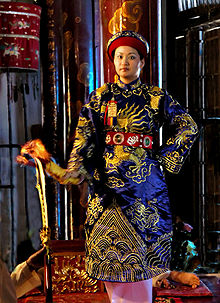
Đạo Mẫu (道母) is the worship of mother goddesses which was established in Vietnam in the 16th century.[1] This worship is a branch of Vietnamese folk religion but is more shamanic in nature. Đạo is a Sino-Vietnamese word for "religion," similar to the Chinese term dao meaning "path," while Mẫu means "mother" and is loaned from Middle Chinese /məuX/.
While scholars like Ngô Đức Thịnh propose that it represents a systematic worship of mother goddesses, Đạo Mẫu draws together fairly disparate beliefs and practices.[2][3][4][5][6] These include the worship of goddesses such as Thiên Y A Na, Bà Chúa Xứ "Lady of the Realm", Bà Chúa Kho "Lady of the Storehouse", and Princess Liễu Hạnh,[7] legendary figures like Âu Cơ, the Trưng Sisters (Hai Bà Trưng), and Lady Triệu (Bà Triệu), as well as the branch Four Palaces.
Practices

Serving the reflections (hầu bóng)


The most prominent ritual of Đạo Mẫu is the ceremony of hầu bóng (lit. 'serving the reflections'), in which a priest or priestess mimics the deities by dressing and acting like them. Many people mistake that hầu bóng is a form of mediumship ritual — known in Vietnam as lên đồng — much as practiced in other parts of Asia, such as South China, among the Mon people of Myanmar, and some communities in India; however, that is not correct. Although some of the priests and priestesses of Đạo Mẫu are believed to have the ability of spirit mediumship, this is a different practice entirely. The priest is in full control of their body during hầu bóng. A successful ceremony is one in which the priest feels the deities' essences but it does not mean the deities' spirits enter the priest's mortal body. As a religious leader authorised to perform the sacred rituals of a religion, especially as a mediatory agent between humans and one or more deities, the thanh đồng in Đạo Mẫu is more of the equivalent of a priest rather than a medium or a shaman.
The worshiping of the Mother Goddesses contributes to the appreciation of women in society. Recognized by UNESCO, this Vietnamese ritual was inscribed on Representative List in December 2016.[8]


Although the Vietnamese government had initially proscribed the practice of such rituals, deeming them to be superstitions, they relented in 1987, once again permitting their practice.
Denominations

Four Palaces (Tứ Phủ)
The most prominent form of Đạo Mẫu is Four Palaces (Tứ Phủ), which worships a hierarchical pantheon of Vietnamese indigenous deities with a strong influence from historical figures, Taoism and Buddhism. Four Palaces is the most common in the North. Other forms in different areas have also developed an interference with other local beliefs. The name literally means "Four Palaces", which includes the four realms Heaven, Mountains, Water and Earth.
Mother Goddess (Thánh Mẫu)
-
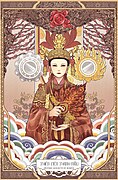 A portrait of the First Mother Goddess of Heaven in the Lê dynasty's costumes. This painting is from the project Divine Portraits by Four Palaces - Tứ Phủ.
A portrait of the First Mother Goddess of Heaven in the Lê dynasty's costumes. This painting is from the project Divine Portraits by Four Palaces - Tứ Phủ. -
 A portrait of the Second Mother Goddess of Earth in the Lê dynasty's costumes. This painting is from the project Divine Portraits by Four Palaces - Tứ Phủ.
A portrait of the Second Mother Goddess of Earth in the Lê dynasty's costumes. This painting is from the project Divine Portraits by Four Palaces - Tứ Phủ. -
 A portrait of the Third Mother Goddess of Water in the Lê dynasty's costumes. This painting is from the project Divine Portraits by Four Palaces - Tứ Phủ.
A portrait of the Third Mother Goddess of Water in the Lê dynasty's costumes. This painting is from the project Divine Portraits by Four Palaces - Tứ Phủ. -
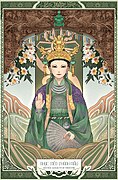 A portrait of the Fourth Mother Goddess of Mountain in the Lê dynasty's costumes. This painting is from the project Divine Portraits by Four Palaces - Tứ Phủ.
A portrait of the Fourth Mother Goddess of Mountain in the Lê dynasty's costumes. This painting is from the project Divine Portraits by Four Palaces - Tứ Phủ.
Holy Courtiers (Thánh Chầu)
-
 A portrait of the First Courtier of Heaven. This painting is from the project Divine Portraits by Four Palaces - Tứ Phủ.
A portrait of the First Courtier of Heaven. This painting is from the project Divine Portraits by Four Palaces - Tứ Phủ. -
 A portrait of the Second Courtier of Mountains and Forests. This painting is from the project Divine Portraits by Four Palaces - Tứ Phủ.
A portrait of the Second Courtier of Mountains and Forests. This painting is from the project Divine Portraits by Four Palaces - Tứ Phủ. -
 A portrait of the Third Courtier of Water Palace. This painting is from the project Divine Portraits by Four Palaces - Tứ Phủ.
A portrait of the Third Courtier of Water Palace. This painting is from the project Divine Portraits by Four Palaces - Tứ Phủ. -
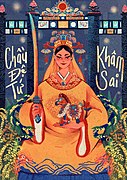 A portrait of the Fourth Courtier, Imperial Commissioner. This painting is from the project Divine Portraits by Four Palaces - Tứ Phủ.
A portrait of the Fourth Courtier, Imperial Commissioner. This painting is from the project Divine Portraits by Four Palaces - Tứ Phủ.
Holy Mistresses (Thánh Cô)
-
 A portrait of the First Mistress of Heaven. This illustration is from the project Divine Portraits by Four Palaces - Tứ Phủ.
A portrait of the First Mistress of Heaven. This illustration is from the project Divine Portraits by Four Palaces - Tứ Phủ. -
 A portrait of the Second Mistress of Mountains and Forests. This illustration is from the project Divine Portraits by Four Palaces - Tứ Phủ.
A portrait of the Second Mistress of Mountains and Forests. This illustration is from the project Divine Portraits by Four Palaces - Tứ Phủ. -
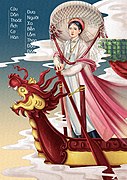 A portrait of the Third Mistress of Water Palace. This illustration is from the project Divine Portraits by Four Palaces - Tứ Phủ.
A portrait of the Third Mistress of Water Palace. This illustration is from the project Divine Portraits by Four Palaces - Tứ Phủ. -
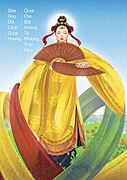 A portrait of the Fourth Mistress of Earth Palace. This illustration is from the project Divine Portraits by Four Palaces - Tứ Phủ.
A portrait of the Fourth Mistress of Earth Palace. This illustration is from the project Divine Portraits by Four Palaces - Tứ Phủ.
See also
- Trưng sisters
- Lady Triệu
- Phùng Thị Chính
- Bùi Thị Xuân
- Matriarchy
- Thiều Dương Thánh Mẫu
References
- ^ Asian Ethnology, Volumes 67-68 2008 p.305 "mother goddess religion (Đạo Mẫu)"
- ^ Ngô Đức Thịnh,"The Cult of the Female Spirits and the Mother Goddesses 'Mẫu'," Vietnamese Studies 121, no.3 (1996):83-96
- ^ "Đạo Mẫu ở Việt Nam" [The Mother Goddess Religion in Vietnam] (Hà Nội: Nhà Xuất Bản Văn Hóa Thông Tin, 1996)
- ^ "The Pantheon for the Cult of Holy Mothers," Vietnamese Studies 131, no.1 (1999): 20-35
- ^ "The Mother Goddess Religion: Its History, Pantheon, and Practices," by Ngô Đức Thịnh, in Fjelstad, Karen; Nguyễn, Thị Hiền (2006). Possessed by the Spirits: Mediumship in Contemporary Vietnamese Communities. SEAP Publications. pp. 19–30. ISBN 978-0-87727-141-3.
- ^ Fjelstad, Karen; Nguyễn, Thị Hiền (2006). Possessed by the Spirits: Mediumship in Contemporary Vietnamese Communities. SEAP Publications. p. 38. ISBN 978-0-87727-141-3.
- ^ Nguyen Quoc Tan, Mother Goddess Liễu Hạnh under the View of Religious Studies, Religious Studies Review Vol. 1, No. 2 – May 2007.
- ^ "UNESCO - Practices related to the Viet beliefs in the Mother Goddesses of Three Realms". ich.unesco.org.
External links

- Đạo Mẫu Việt Nam
- Đạo Mẫu Đông A Phủ
- v
- t
- e
| |||||||||||||||||||||||||||||||||||||||||||||||||||||
|
Topics | |||||||||||||
|---|---|---|---|---|---|---|---|---|---|---|---|---|---|
| |||||||||||||
Religion by country | |||||||||||||
|---|---|---|---|---|---|---|---|---|---|---|---|---|---|
| |||||||||||||
 Category
Category Portal
Portal























